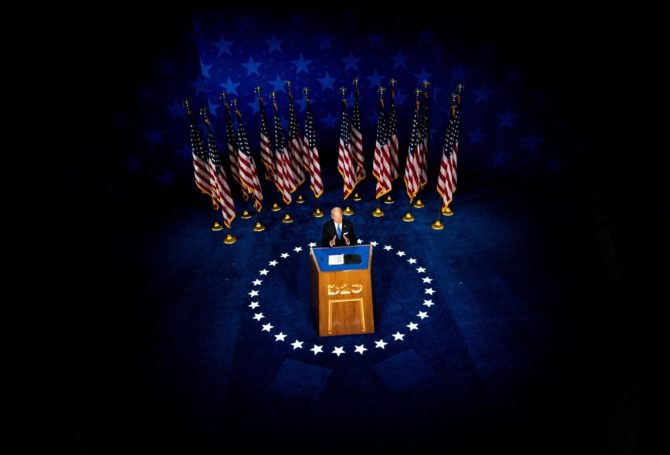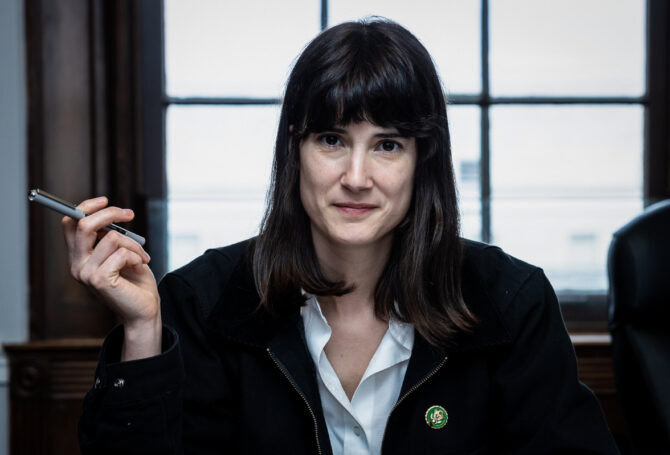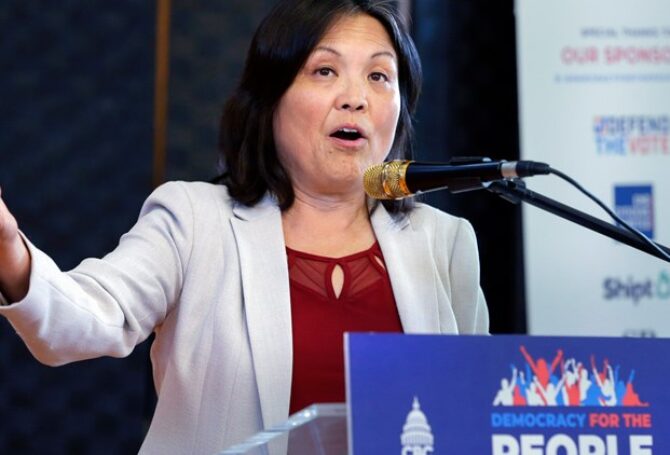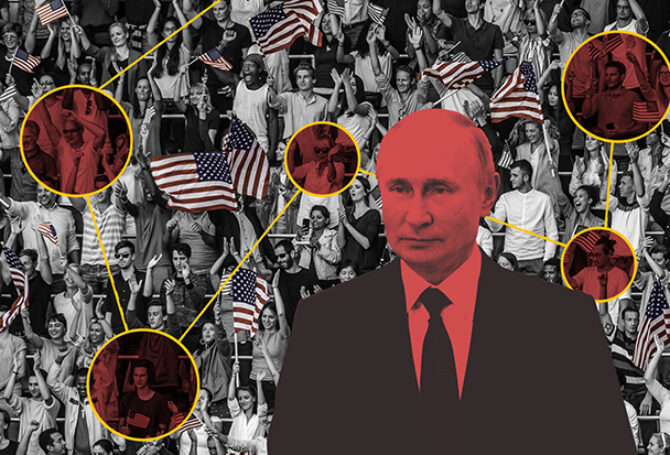
The delegate-stuffed hall, slow-moving agenda and session-ending balloon drop are gone from this year’s virtual nominating presidential nominating conventions, leaving open the question of whether the convention bounce in the polls is history, too. We’ll see.
Democrats concluded their four-day, slickly produced Zoom conference call last week and the Republicans will take their turn on TV this week. The Democratic convention had the feel of a nostalgic This is Your Life episode featuring Joe Biden’s early political success, personal tragedies and daily train rides between Washington, DC and Wilmington, Delaware. The Republican convention, with President Trump speaking every night, may resemble his daily coronavirus briefings.
In addition to the formality of blessing a major-party nominee, conventions are an opportunity to make an argument for a candidate, which will echo for the remaining weeks until the November 3 election. Conventions also boost a candidate’s poll results, known as the convention bounce. However, the bounce has never been a sure or permanent thing.
Bill Clinton’s poll numbers shot up 16 percent after the 1992 Democratic convention. John Kerry’s poll numbers barely inched up after the 2004 convention. In 2008, John McCain seized a small lead over Barack Obama after the GOP convention, which melted away in the fall. George W. Bush saw his 16-point lead over Al Gore evaporate after the Democratic convention when Gore enjoyed an 8-point convention bounce. Bush equaled Gore with an 8-point bounce after the Republican convention.
All those conventions had hoopla, intrigue and a congregation of delegates in a hall, surrounded by a city with armies of supporters, lobbyists and hospitality center bartenders. This year’s conventions won’t have much of that. The Democratic convention ended with a fireworks display in a parking lot. Trump is planning to give his acceptance speech in the newly renovated White House rose garden.
Both conventions will be attended by larger numbers of campaign aides and Secret Service agents than boisterous supporters.
It may not matter because much of the convention bump is generated by TV audiences who tune in. Live viewership for last week’s Democratic convention slowly built to a crescendo of 24.6 million on the final night when Biden gave his acceptance speech. Comparatively, that was more than 20 percent lower than viewership of closing night at the 2016 Democratic convention.
Presidential nominating convention hoopla, crowded convention halls and tipsy delegates won’t be on display this year and could be part of bygone political history. But will the same be true for the convention bounce – that surge of support in the afterglow of a successful convention? We’ll see.
One potentially big difference between the 2020 conventions and previous conventions is the growing number of people, especially younger adults, who watch events like this online or via live streaming, which isn’t captured in viewership numbers. Those eyeballs, when translated into election turnout, could be more valuable than post-convention polling numbers.
Another difference is the political bifurcation of TV networks. MSNBC produced a giddy eight-plus hours of coverage of the Democratic convention, giving the left-leaning network its highest prime-time ratings in its 24-year history. Fox News, the preferred network of conservatives, only devoted its 10 pm time slot nightly to coverage of the Democratic convention, recording its lowest nightly viewership this year. Expect those ratings to flip this week, suggesting perhaps more than ever before conventions are playing to the choir, not the unconvinced.
Yet another difference is in the higher production values of the virtual 2020 conventions compared to in-person events. In the Democratic convention, most speeches were short and interspersed with high-quality videos and musical performances. The two-hour telecasts moved along smartly, with the aid of a host that changed nightly. There was strict adherence to campaign messaging, enforced by video editing. Virtually every segment urged viewers to text to get information about how to vote – and where to send a donation. Democrats claimed to raise $70 million over four nights. Republicans can be expected to conduct a similarly styled convention this week, with Trump as the nightly wild card.
Going into the conventions, Biden has held a fairly consistent lead over Trump in the polls, sometimes edging up into double digits. If history repeats itself this year, Biden’s lead in the polls will temporarily increase, then fall back after the Republican convention. However, this has been anything but a typical year.
An ABC News/Ipsos post-convention poll found Joe Biden’s favorability rating bounced up 5 points to 45 percent. That’s twice as large as the average bounce for presidential candidates of both parties since 2004, according to data from the American Presidency Project.
Biden’s bump was slightly larger for Democrats (86 percent from 79 percent). Black Americans gave Biden a 69 percent favorability rating, Hispanics 52 percent and whites 39 percent. The poll was conducted Friday and Saturday with a random sample of 714 adults and a margin of error of 4 percentage points.
Kamala Harris also benefitted from a convention bounce – up 10 points among respondents familiar enough with her to have an opinion. Her approval rating among Black Americans increased from 52 to 67 percent. Her overall favorability rating among Democrats hit 77 percent.
The same poll showed President Trump’s favorability rating at 32 percent, with an unfavorable rating of 60 percent. Vice President Mike Pence’s favorability rating was 30 percent, with an unfavorable rating of 46 percent.
There undoubtedly will be more poll results released this week, but the polling of greatest interest will occur after the Republican convention, which will reveal whether there was a bounce and whether it will last.
Convention bounces still count, but they’ve gotten smaller
Post-convention bounce in voter preferences in polls, 1968 to 2016
| YEAR | PARTY | DATES | NOMINEE | BOUNCE |
| 2016 | R | July 18-21 | Donald Trump | +3 |
| 2016 | D | July 25-28 | Hillary Clinton | +2 |
| 2012 | R | Aug. 27-30 | Mitt Romney | -1 |
| 2012 | D | Sept. 3-6 | Barack Obama | +2 |
| 2008 | D | Aug. 25-28 | Barack Obama | +4 |
| 2008 | R | Sept. 1-4 | John McCain | +6 |
| 2004 | D | July 26-29 | John Kerry | -1 |
| 2004 | R | Aug. 30-Sept. 2 | George W. Bush | +2 |
| 2000 | R | July 31-Aug. 3 | George W. Bush | +8 |
| 2000 | D | Aug. 14-17 | Al Gore | +8 |
| 1996 | R | Aug. 12-15 | Bob Dole | +3 |
| 1996 | D | Aug. 26-29 | Bill Clinton | +5 |
| 1992 | D | July 13-16 | Bill Clinton | +16 |
| 1992 | R | Aug. 17-20 | George H.W. Bush | +5 |
| 1988 | D | July 18-21 | Michael Dukakis | +7 |
| 1988 | R | Aug. 15-18 | George H.W. Bush | +6 |
| 1984 | D | July 16-19 | Walter Mondale | +9 |
| 1984 | R | Aug. 20-23 | Ronald Reagan | +4 |
| 1980 | R | July 14-17 | Ronald Reagan | +8 |
| 1980 | D | Aug. 11-14 | Jimmy Carter | +10 |
| 1976 | D | July 12-15 | Jimmy Carter | +9 |
| 1976 | R | Aug. 16-19 | Gerald Ford | +5 |
| 1972 | D | July 10-13 | George McGovern | 0 |
| 1972 | R | Aug. 21-23 | Richard Nixon | +7 |
| 1968 | R | Aug. 5-8 | Richard Nixon | +5 |
| 1968 | D | Aug. 26-29 | Hubert Humphrey | +2 |
| Average | +5 |
A post-convention bounce is the change in a candidate’s polling average one week before the party’s convention and one week after.
SOURCE: THE AMERICAN PRESIDENCY PROJECT



